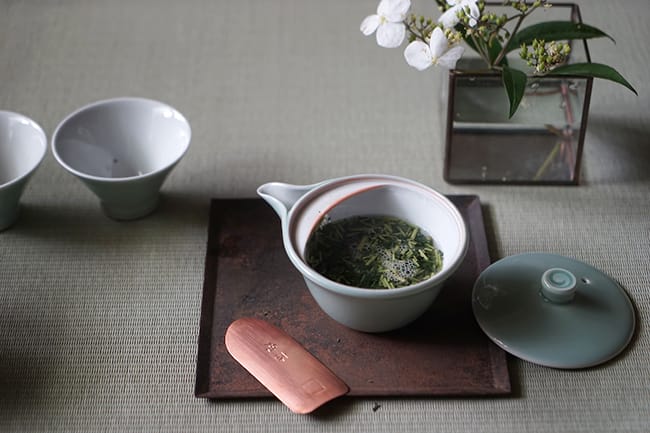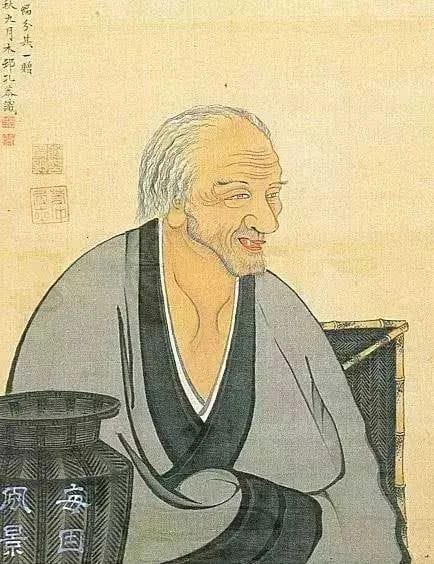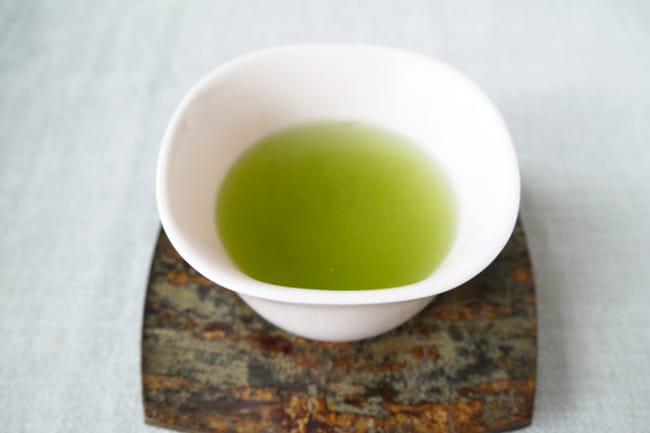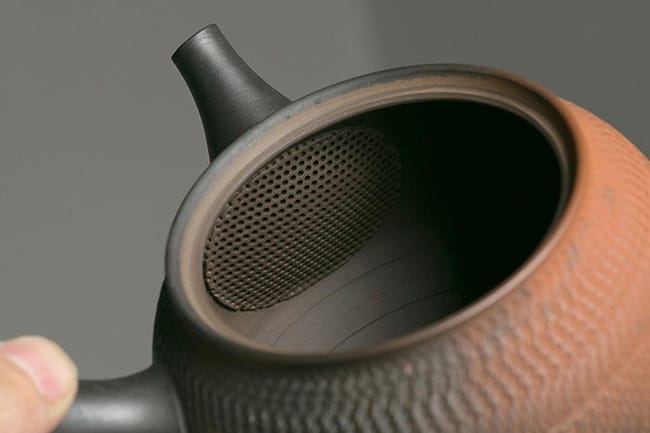Last Updated on 10/22/2021 by Desmond
Matcha and the complex Sado may be the first impress when we talk about Japanese tea. Actually, in Japanese ordinary daily life, a kind of green tea called Sencha takes the absolute position. It got a more affordable price and an easier preparation way.
CONTENT
History of Sencha
Sencha can’t be popular among the Japanese civilians without the outstanding contributions of two people – Nagatani Soen (永谷宗円)and Baisao(売茶翁).
We know that the tea-drinking habit was spread to Japan from Tang China about 1400 years ago. Japanese developed their own style of Matcha and Sado based on the Chinese old tea ceremony.
This exquisite tea-drinking etiquette was only popular among the Japanese upper-class. The tea most civilians drank, which only been through rough processing, and they drank it in a simple way. This kind of loose leaf was called Sencha, and it was without a uniform and standard processing method. People just harvested the fresh leaves, fixed them by frying, cooking, or steaming, then rolling with a bamboo mat, finally drying by the sun. Although sometimes they may windfall some high-quality leaves, the total quality couldn’t catch the Tencha, which the rich people consumed.
Nagatani Soen was born in 1680 in Yuyatani Village, where nearby Uji, the most famous tea-production of Japan. Soen definitely knew how to cultivate and process tea. However, the government at that time only allowed certified tea masters to produce Tencha. Thus, Soen planned to consult the ordinary peasant’s Sencha processing method and develop a high-quality and good-taste tea, which can offer general people.
The local folks would decoct the tea stems which screened from Tencha processing for a drink. These tea stems have not been rolling, so that they must be cooked the get the flavor when brewing. The infusion shows tan, tastes, and smells well. Soen got inspiration from it, and he decided to add the processing methods, like steamed fixation and furnace drying, into his Sencha production.
In the brand new Sencha process way, leaves are picked from the ordinary cultivated Camellia Sinensis(the high-class Tencha, leaves are harvested from the shaded tea trees.) After the steamed fixation, leaves will be placed on a wood plate, with a furnace burning under it, rolling and drying simultaneously. This can be said a creative leap. Because before it, the folk tea masters were rolling the leaves on the bamboo mat, and leaves were easy to break because they still contained much water. And the bamboo smell and sun-drying are also influencing the Sencha flavor a lot.
Nagatani Soen spent 15 years on this with millions of tests to get the best result. This method becomes the major Japanese green tea processing way later. Due to the beautiful green color of the infusion, people called the tea Green Sencha; or Uji Sencha, based on where it originated. Nagatani Soen was also honored as the “Ancestors of the Sencha.”
Not a long time later, Soen brought this brand new Sencha to Edo, where the cultural and political center of Japan at that time, and hoped it would gain the civilians’ favor and spread out. But this new type of Sencha was much different from the old ones, especially the color; the Edo tea merchants dared not to invest in it prematurely. Fortunately, Soen met Yamamoto Kahei, the second-generation owner of the old and famous brand Yamamotoyama Tea Company, who gave him a big help. By the way, his descendant was the inventor of Japanese high-class green tea Gyokuro.
Yamamoto Kahei loved Soen’s Sencha much after simply taste. They got cooperation at once. Kahei branded the tea with a “Top of the World” name and sale. As they wished, this new Sencha became popular soon. One great thing that Soen did was he didn’t hide his Sencha processing method as a secret, but public it and actively taught other farmers and tea masters.
Another guy who made a significant contribution to Sencha’s promotion is Baisao; it’s a nickname, means “old tea seller.” He used to be a Buddhist monk. When he was 57, he gave up the opportunity to be the temple abbot and came to Edo selling tea. Baisao learned how to make Sencha when he was 60 and made friends with Nagatani Soen. He set up a tea shop, which was the first one in Japan.
Baisao also disagreed with the tea-drinking way of the upper class, and he opposed the complex preparing method and the teawares comparisons. He advocated that drinking tea should be a frugal and straightforward behavior. Sencha was prepared very simply in his store, just to put the leaves into the boiling water and cook for a while. Baisao also loved to tea and chat and discussed Zen with kinds of people. Therefore, the refined scholars from the upper class and the farmers are all friends with him.
Baisao did a great job on Sencha’s promotion, and he also realized that he was getting famous. For avoiding the later generations getting blind worship on him, when he felt his day nearly come, he burned almost his teaware all. Ironically, later there was still someone, repaired his teawares and tea-making method, set up Senchado, and honored him as the founder.
How Is Sencha Processing
Sencha is still the most popular tea in Japanese society now, its yields close to 80% of the total. The tea tree species for making Sencha is not much different from the other Japanese teas’, and almost all the production areas produce Sencha. Shizuoka, Kagoshima, Saitama(Sayama), and Kyoto(Uji) are the major production areas; among them, Shizuoka and Uji are the most famous.
The significant difference between Sencha and high-grade Japanese green tea Gyokuro and Matcha is the planting mode. In another article(here), we’ve learned that the leaves for making high-grade green tea will be shaded about 20 days before harvested. It’s for reducing the sunshine and inhibiting the amino acid turn to tea polyphenols and tannie(they make the tea taste bitter.)
Most plants for producing Sencha will not be cultivated in this shaded mode. It was the starting point of Nagatani Soen’s Sencha improving plan – making the leaves harvest easier. In fact, this distinguish has a limited. Because nowadays, there is some high-class Sencha also made from the shaded leaves. That’s why the difference between high-class Sencha and Gyokuro is so vague.
Like most other teas, leaves harvested in the early spring are regarded as the best and delicious. Because the Japanese tea plantations only harvest in spring, summer, and autumn, the spring leaves contain all the benefits and flavor substances stored in the whole winter. Especially the leaves which have been shaded, they contain more amino acids and make unique umami.
Leaves after picking will be steamed fixation for stopping oxidation. In modern times, this part is done with machines; it can control the steaming time more accurately. Sencha also classified by the steaming time they been:
- Light steaming(浅蒸し): about 20-30 seconds
- Medium steaming(中蒸し): about 30-40 seconds
- Deep steaming(深蒸し): about 40-60 seconds
- Special steaming(特蒸し): about 90-120 seconds
- Ultra steaming(極蒸し): about 140-160 seconds
By the extension of steaming time, the final Sencha infusion will turn deep green from light yellow. The flavor also becomes much more robust, especially the umami taste. But the fresh aroma it sent reduced.
The next step is rolling. Tea masters roll the leaves with their adept skill, primary, further, finally to delicate, making them tight. The tea masters will do more seriously when they treat the high-quality leaves, rolling them tiny like needles and looking more beautiful.
Traditionally, the rolling and drying of Sencha are done together on a plate with a furnace burning under it, that’s for feel and control the leaves’ water better. Now, most tea factories in Japan will also do these jobs with machines for a larger yield and uniform quality. Of course, the high-class leaves are still processed by tea masters’ handwork in the traditional way; it can get a higher value.
Sencha Flavor Notes
Japanese Sencha tastes much different from Chinese green tea. Sencha is fixed in a steaming way, retains a more natural, fresh, and grassy flavor, and has a noticeable astringency. Chinese green teas are most fixed in a frying way, the roast flavor takes a more prominent part.
However, the most significant characteristic of Japanese Sencha is the strong umami. This is a taste similar to the kelp soup, or you can say it taste like MSG. Japanese love this flavor deeply; I think it is because Japan is an island country. The tea with more robust umami is typically regarded with better quality.
The umami taste is from the rich amino acid content of the leaves. Especially the leaves which been through shaded, the amino acid content gets higher, and the less tannin also makes the umami shows evident. Extensive use of nitrogenous fertilizer during cultivation is also for this goal.
Besides, the processing also has an influence on the Sencha flavor. A deeper steaming will make the plant smell and bitterness less but condense the umami. A finer rolling also makes the umami substances easier to dissolve to the infusion and taste more robust.
Sencha Benefits and Potential Side Effects
Benefit by the tea polyphenols, EGCG, and caffeine, etc. from the Camellia Sinensis, having Sencha can get the same benefits as the other green teas, like:
- antioxidant
- anti-inflammatory
- weight loss
- anti-aging
- mind refreshing
- …
All these benefits may not be as evident and efficient as you think; they are influenced by many factors. An interesting fact, although Sencha generally contains more caffeine than Matcha, it may cause lesser side effects. Because Matcha consumes all the leaves, and the caffeine in Sencha is harder to dissolve in your cup and absorbed by you.
Even so, people who are sensitive to caffeine still need to take care when having Sencha; just like other true teas, it is easy to cause insomnia and nervousness.
How To Prepare Sencha
Sencha owns its special Senchado, an etiquette about brewing and drinking Sencha. It requires many complex and dainty steps, and there are many schools too. It will not be necessary to comply with these etiquettes if we just going to have Sencha simply at home. Of course, you can learn the relative classes if you are interested in it.
Anyway, the teawares used in Senchado indeed have outstanding performance; they are specially made for Sencha preparation. A teapot called Kyusu, with a filter inside and a lateral handle on the body. Sencha are extruded during rolling and made some chippings. They may come to your cup if without a filter; that’s not so good-looking and influences the mouthfeel. There is also a kind of Kyusu with handles called houhin, which is better for brewing Gyokuro.
- Boil the water and preheat the teawares with it
- Waiting for the water to cool down to 65-75℃
- According to the guests’ number, put the Sencha leaves into the Kyusu, in the ratio of 2g(leaves): 100ml(water)
- Cover, and steep the leaves
- The steeping time for the light-steaming Sencha is about 1 minute; and to the deep-steaming ones, 40-50 seconds will be enough. Take more practice to do it better.
- Pour all the infusion into the cups, do not leave even one drop inside the Kyusu.
- Serving
Most Senchas are just for two brewing. The first round gets the best aroma and flavor, and the second round may taste a little more bitter and astringent because the leaves have already spread out. And in the third brew, there may be only bitter taste left; few people like to do it.





